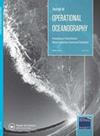观测到的阿拉伯海快速变暖背景下热带气旋驱动的冷尾流
IF 2.4
3区 地球科学
Q4 METEOROLOGY & ATMOSPHERIC SCIENCES
引用次数: 1
摘要
我们对观测到的阿拉伯海气旋引起的表面冷却(或冷尾)进行了详细的长期(1997-2019)分析。在这里,对33个气旋进行了分析,这些气旋在三个不同的季节(季风前、季风和季风后)导致海面显著变冷。我们的研究表明,根据强度、持续时间和其他有助于冷却的因素,气旋在通过后可以使海面降温高达4.76°C。季风和季风前气旋降温较强,季风后气旋降温持续时间较长(8-10天),恢复时间较慢(15天)。总体而言,季风前和季风后气旋与潜热通量具有较强的正相关,而季风后气旋与Ekman泵速、风应力和气旋强度具有较高的相关。对El-Niño年、La-Niña年和Normal年的冷尾复合分析表明,El-Niño年和La-Niña年气旋引起的降温相似,且在印度洋负偶极子(IOD)年降温比正IOD年更占优势。近几十年来,正IOD和La Niña事件的共同出现导致了更强烈的气旋。功率耗散指数、气旋累积能量和海洋热含量也呈上升趋势,有利于气旋的快速增强。由于海温的下降通常会阻碍气旋的增强,因此我们的研究很重要,这项研究的结果将有助于热带气旋的预测。由于近几十年来印度洋的快速变暖,预计在气候变化的背景下,飓风等极端事件将会增加。本文章由计算机程序翻译,如有差异,请以英文原文为准。
Observed tropical cyclone-driven cold wakes in the context of rapid warming of the Arabian Sea
ABSTRACT We present a detailed long-term (1997–2019) analysis of observed cyclone-induced surface cooling (or cold wake) in the Arabian Sea. Here, the analysis is performed for 33 cyclones that drove significant cooling at the sea surface in three different seasons: the pre-monsoon, monsoon and post-monsoon. Our study shows that cyclones can cool the sea surface up to 4.76° C after their passage, depending on the intensity, duration and other factors that contribute to cooling. The monsoon and pre-monsoon cyclones show stronger cooling, but the post-monsoon cyclones exhibit a longer duration (8–10 days) of cooling and slower recovery time (15 days). In general, the pre- and monsoon cyclones exhibit a strong positive correlation with the Latent Heat Flux, whereas the post-monsoon cyclones show a higher correlation with Ekman Pumping Velocity, wind stress and intensity of cyclones. The cold wake composite analysis for the El-Niño, La-Niña and Normal years shows that cyclone-induced cooling is similar in El-Niño and La-Niña years, and the cooling is more dominant during the negative Indian Ocean Dipole (IOD) than that in the positive IOD years. Co-occurrence of positive IOD and La Niña events has led to more intense cyclones in recent decades. The power dissipation index, accumulated cyclone energy and oceanic heat content also show an increasing trend in AS and favour rapid intensification of cyclones. Since the drop in SST normally impedes cyclones from intensification, our study is important and the findings of this study will aid in tropical cyclone predictions. In response to rapid warming of Indian Ocean in recent decades, extreme events such as cyclones are expected to increase in the context of climate change.
求助全文
通过发布文献求助,成功后即可免费获取论文全文。
去求助
来源期刊
CiteScore
7.50
自引率
9.70%
发文量
8
审稿时长
>12 weeks
期刊介绍:
The Journal of Operational Oceanography will publish papers which examine the role of oceanography in contributing to the fields of: Numerical Weather Prediction; Development of Climatologies; Implications of Ocean Change; Ocean and Climate Forecasting; Ocean Observing Technologies; Eutrophication; Climate Assessment; Shoreline Change; Marine and Sea State Prediction; Model Development and Validation; Coastal Flooding; Reducing Public Health Risks; Short-Range Ocean Forecasting; Forces on Structures; Ocean Policy; Protecting and Restoring Ecosystem health; Controlling and Mitigating Natural Hazards; Safe and Efficient Marine Operations

 求助内容:
求助内容: 应助结果提醒方式:
应助结果提醒方式:


